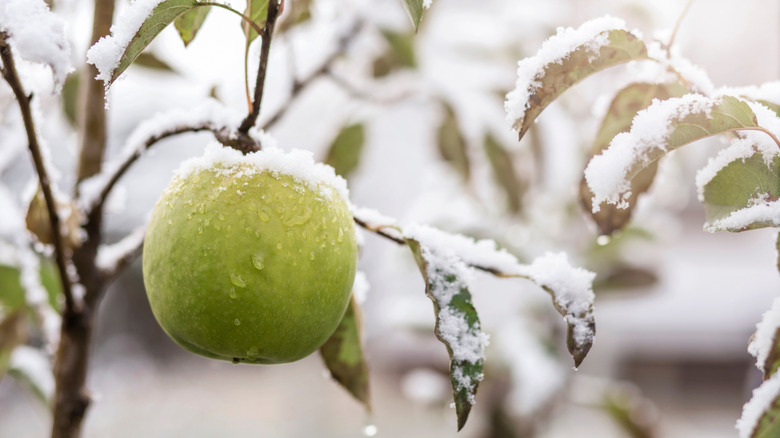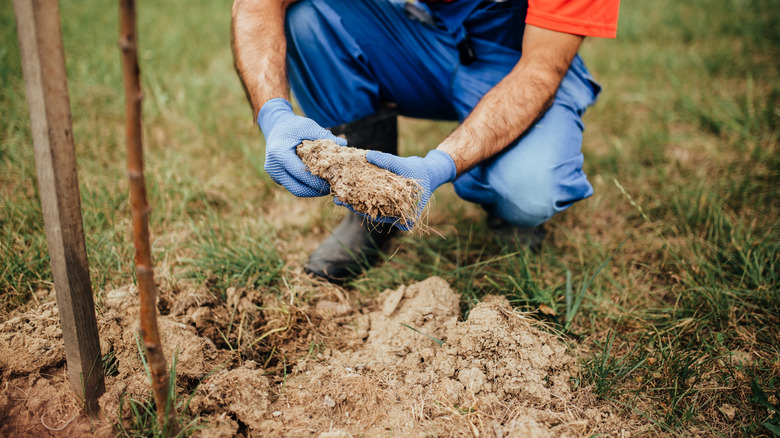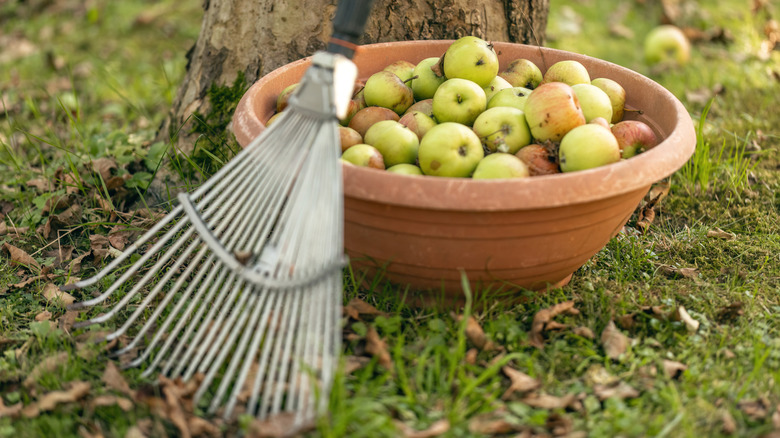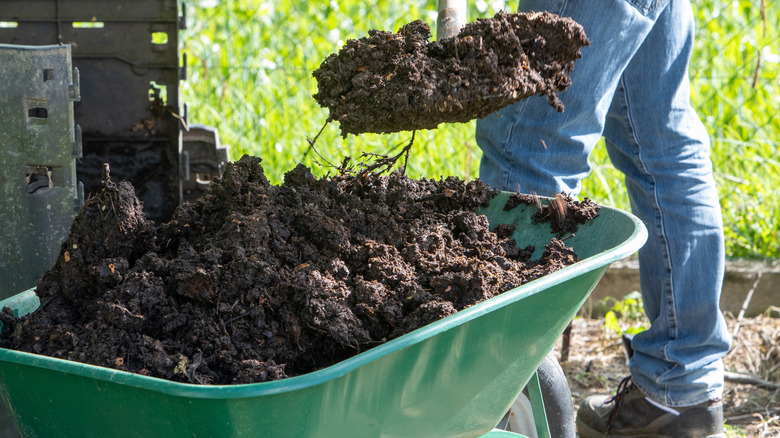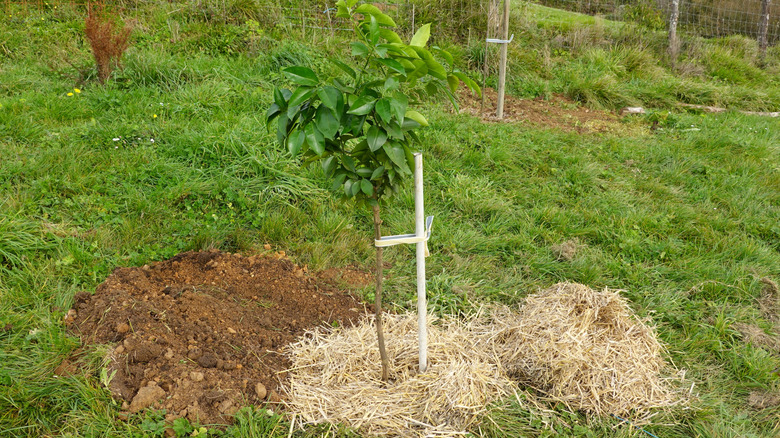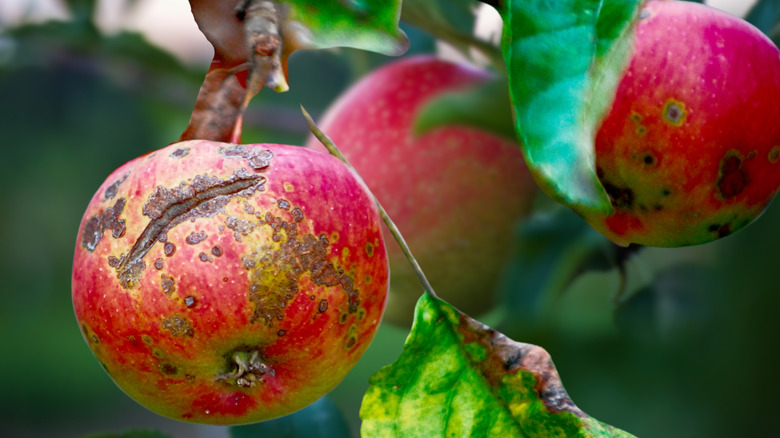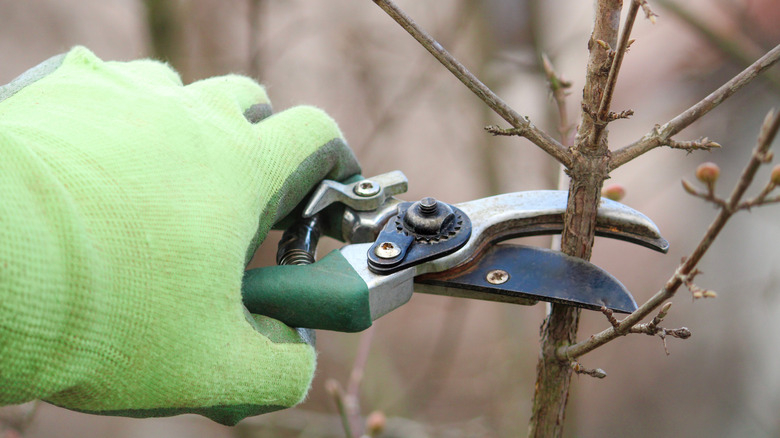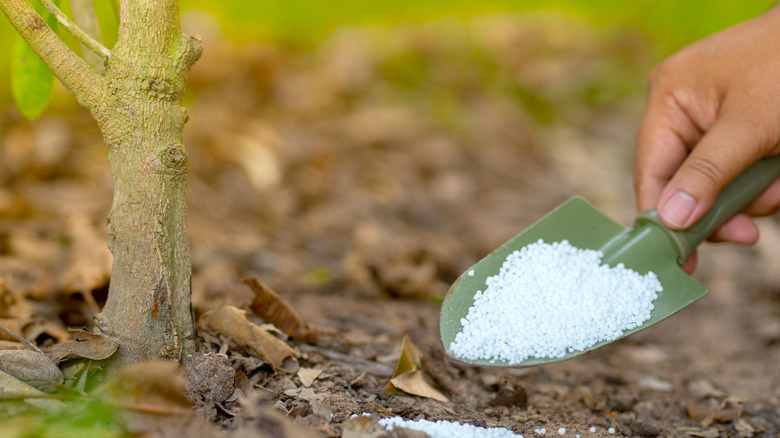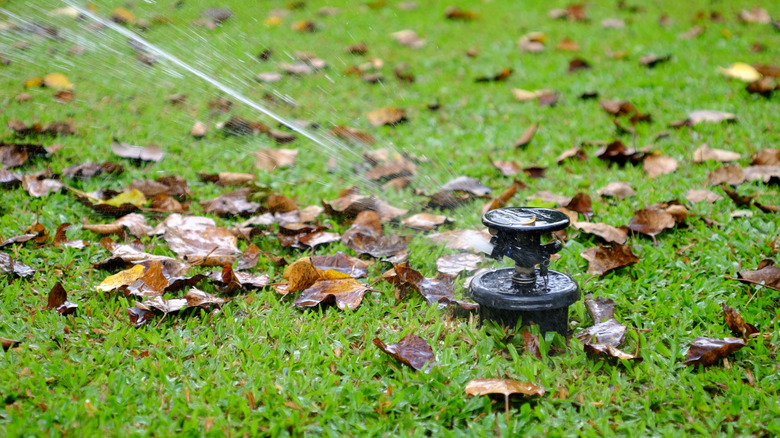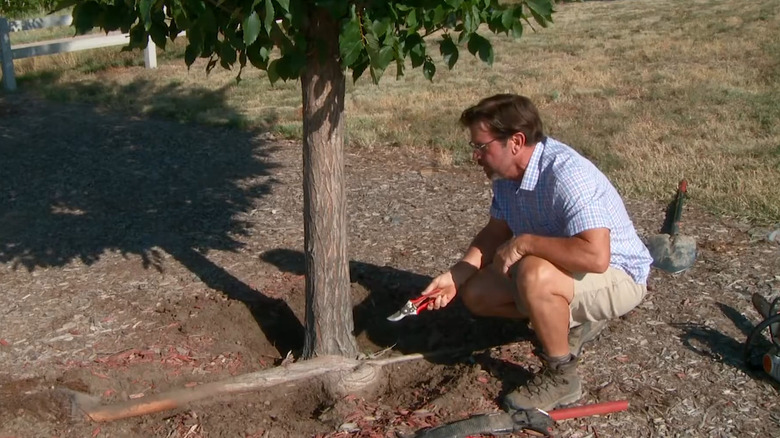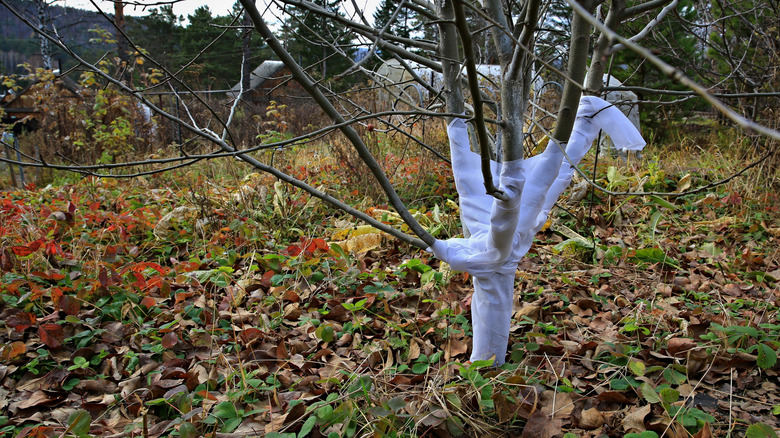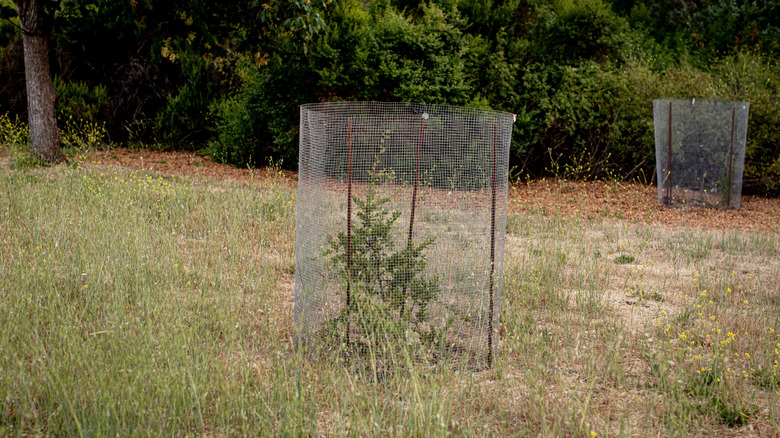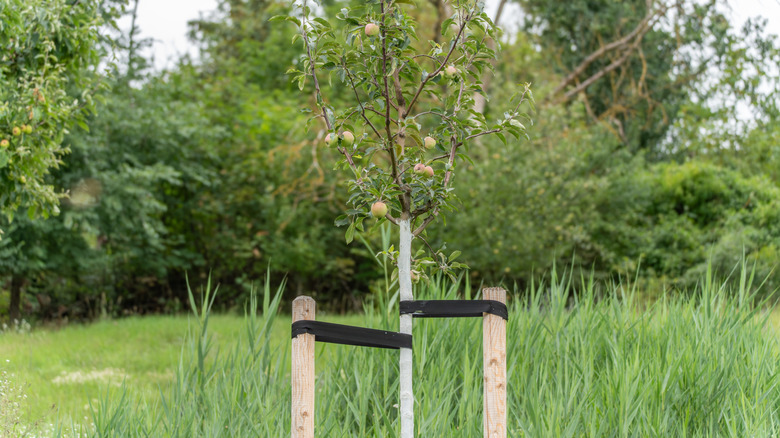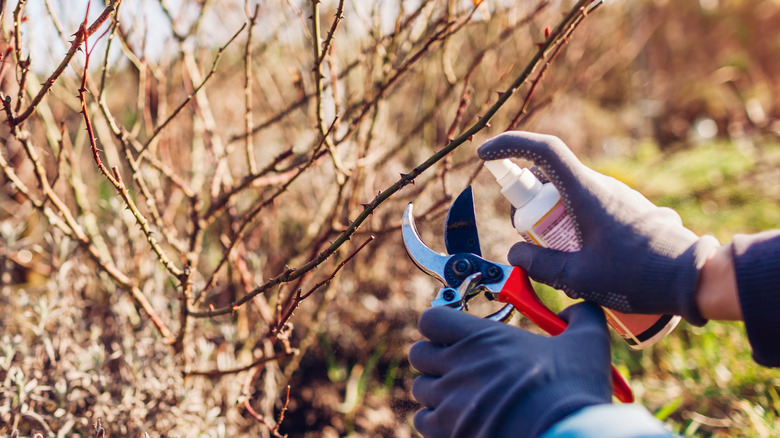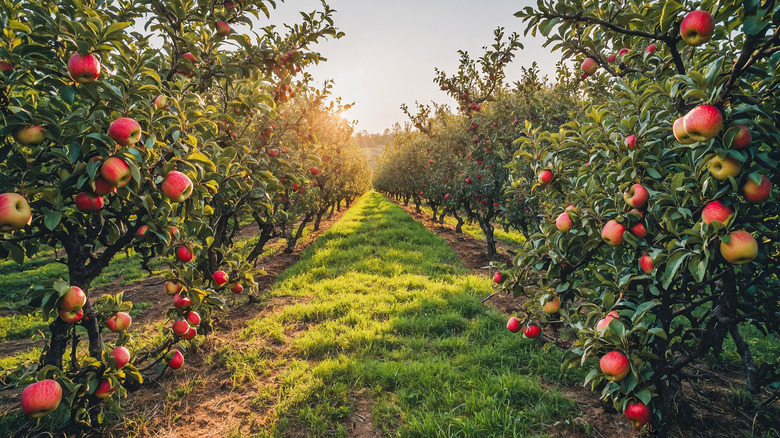14 Steps To Do In October To Winterize Your Fruit Trees
If you're growing fruit, then you know that fall cleanup hasn't really started until you begin to winterize your trees. Once the leaves begin to drop, along with the temperatures, putting your fruit trees to bed for the winter protects them from cold, diseases, and pests. Adequate care in the fall sets your fruit trees up for success, and it can be the reason they produce abundantly in the following season. From keeping your home orchard clean and tidy to doing some light pruning, October is the perfect time to check these 14 essential items off your fall to-do list.
Fruit trees, which are becoming increasingly popular in urban settings, respond to consistent care. While everyone wants to know the best tips and tricks to help fruit trees grow and produce faster, the truth is that growing fruit trees is a science all on its own, and it takes time. Everything matters when it comes to how much your trees produce, from choosing the right variety to understanding common diseases and fruit pollination. Whether you're growing an urban food forest or simply managing the apple tree in your backyard, taking the appropriate steps in the fall ensures healthy trees all year round.
Test the soil around your fruit trees
Fruit trees are abundant producers, and they need a lot of nutrients for the fruit they produce, including minerals like calcium and magnesium. Before you create a plan for amending your soil, you should do a soil test to see what it needs. You also want a balanced pH, which for most fruit trees is between 6.0 and 7.0. After you get the results, you can develop a comprehensive fertilization plan to amend your soil.
Clean up the fallen leaves and fruit
Keeping the area under your fruit trees tidy by cleaning up fallen fruit is one of the top things you can do to prevent diseases and avoid pests. If you're someone who grows fruit trees to bring fall birds to your yard and garden, then you know that fruit trees attract everything from wasps to deer with their abundant harvest. For optimal health of your fruit trees, rake the leaves and remove any dropped fruit to keep the area around them clean.
Place a layer of compost around your fruit trees
If you're looking for a truly low-maintenance approach to lawn care, you can leave the leaves around trees in the fall because they'll decay and add organic matter to your soil. However, fruit tree leaves and fallen fruit can attract pests and harbor diseases, so it's better to send those materials to the compost pile. Then, place a layer of finished compost around your fruit trees, at the rate of 1 cubic foot for every 3 feet of tree height.
Mulch around the base of your fruit trees
A layer of clean mulch around the base of your fruit trees insulates the roots and helps the soil retain moisture. Even dormant fruit trees transpire minute amounts of water through the winter. The wind and cold, combined with the freezing and thawing action, pull moisture from the soil, leaving bare roots vulnerable to desiccation. Mulch not only provides some insulation to help avoid cold damage, but it also keeps the roots and soil hydrated.
Inspect your fruit trees for pests and diseases in October
Give all your fruit trees an inspection at the end of the season to determine if there are any signs of aphids, fungal infections, or scale. Different fruit trees are susceptible to various diseases and pests, so it's helpful to have a solid understanding of what to look for with the type of tree you're growing. Then, you can apply treatments like oil sprays once the tree is fully dormant for the season.
Prune dead and diseased branches
Fall is not the time for pruning on a large scale, but after the leaves drop, October is a good time of year to get rid of dead, damaged, or slightly diseased branches so they don't cause further damage. Diseased limbs can continue to spread infections, and broken limbs may lead to more extensive breakage. Avoid heavy pruning, which can encourage late-season growth that's too tender for cold snaps. It might be tempting to apply a layer of sealant on exposed areas, but this is not generally recommended.
Choose the right fall fertilizer for your fruit trees
While aged manure and compost are good for fruit trees in the fall, not everyone has access to these. If you're using synthetic fertilizers, fall is the time to switch to a balanced, slow-release formula. You want to avoid anything with nitrogen since that encourages leaf growth and can make your trees susceptible to winter injury. Instead, choose fertilizers with phosphorus, potassium, or other minerals that showed up as deficiencies in your soil test.
Water your fruit trees thoroughly in the fall when the soil is dry
Whether it's your lawn, flower beds, or fruit trees, fall watering can be tricky. The goal is to have fully hydrated root systems going into winter, since well-hydrated trees are more resilient to the cold and wind. You don't want to let your fruit trees (or your other plants) dry out completely, so give them a deep watering in October if there's no rain and the soil is dry. However, it's also important to avoid overwatering, which can lead to root rot.
Check your trees for girdling roots
Every so often, a tree will have girdled roots, which can become a problem as the tree ages and may eventually require its removal. Girdled roots can happen if a tree has been in a pot too long or if another root from a larger tree gets in the way. If you find a girdled tree, you may be able to save it with some strategic root pruning. Look out for signs that show up in the fall, like early color and leaf drop, and consider calling in an arborist for specialized treatment.
Wrap or protect young trees from winter damage
Wrapping young trees protects them from frost damage and prevents girdling — not of the roots, but of the trunk. In the middle of winter, rodents nibbling at the bark can strip away enough to kill the tree, a process known as girdling. Young trees are more susceptible to this type of damage, but you can prevent it by using tree guards, burlap, or frost wrap around the base of the tree. This solution also protects trees from frost damage and sunscald, which can split a seam down the trunk.
Protect your fruit trees from wildlife
Fruit trees are nutritious, which is what makes them so desirable for both humans and wildlife. Deer love to nibble at the tender branches for sustenance throughout the winter months. Mice and voles will chew on the bark and girdle them. And if you live in an area with bears, they will break branches to get at the fruit. Using an 8-foot tall deer proof fence for your orchard is the most effective, but you can also put a tree cage around each individual tree.
Remove stakes, ties, and anchors from fruit trees
Winters can be long and brutal, with wind whipping around and ice and snow everywhere. The stakes and ties anchoring your tree and encouraging it to grow straight may become a hindrance during the winter. Usually, spring-planted trees can have their stakes removed in the fall, but if your tree still isn't straight, leave the tie on loosely. You can also take it off and re-tie it in the spring.
Clean and store your tools for the winter
Your fruit tree tools, including loppers, hand pruners, and limb saws, should be cleaned before you put them away for the winter. Tool cleaning is the fall maintenance task that helps protect plants from disease. Use a solution of 1 part bleach to 9 parts water, and spray all your tools. Then, wipe them dry before putting them away. While you're at it, apply some linseed oil. Not only is it an eco-friendly solution that protects your tools from rust, but it's also good for wood handles.
Plan for next season
Okay, technically, this one can be done any time of year. That's what gardeners do anyway — look ahead to the future. Planning is important, and as the years go by, the needs of your fruit trees will change. As you work through your October to-do list, make notes about what worked and what didn't. Consider disease-resistant trees you may need to plant to replace ones that aren't working out. Then, write down your ideas for pruning, pollination, and soil improvements so you know exactly what steps to take in the spring.
